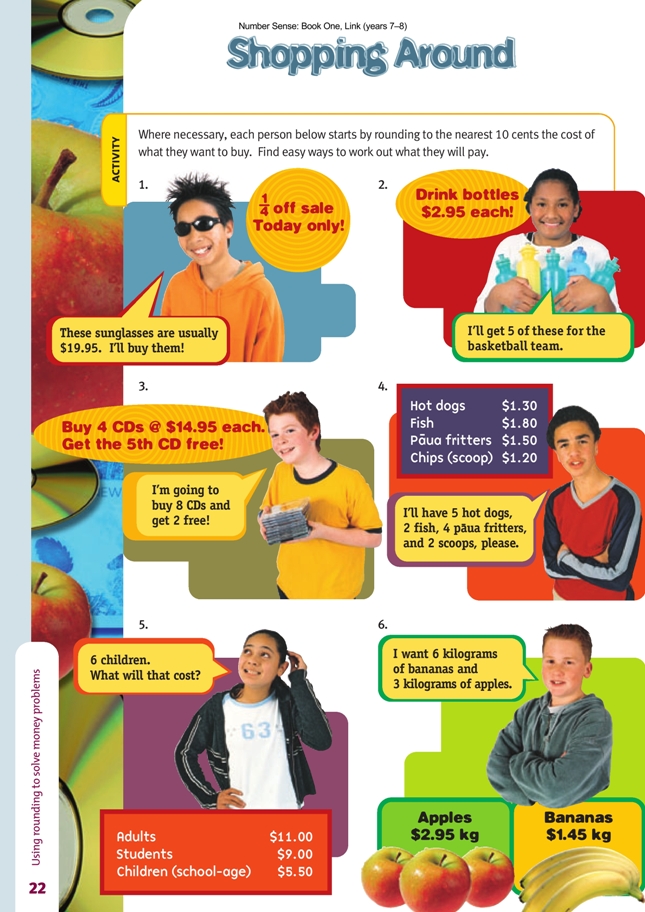This is a level 3 number activity from the Figure It Out series. It relates to Stage 6 of the Number Framework.
A PDF of the student activity is included.
Click on the image to enlarge it. Click again to close. Download PDF (659 KB)
round to the nearest dollar
use multiplication facts to solve problems
This activity is designed to encourage the students to develop rounding skills as they seek easy ways to solve money problems.
Ask the students to attempt to solve most of the problems mentally before they write out any working as this will encourage them to develop thinking strategies that are easy for them without relying on the working forms they have been taught.
Question 2 involves 25 cents over the 5 drink bottles if the base price is rounded to the nearest dollar, so you may choose to ask the students to adjust their rounded answer to be more accurate in this case. Similarly, with question 5, if the students round to $6, they will need to subtract 6 x 50 cents = $3 from their rounded
total.
Question 3 presents an opportunity for the students to use a variety of strategies, but at the same time, it sets a trap for those who do not read the question carefully. If the students simply cost out 10 CDs, they have missed the offer of a free 1 for every 4 they purchase. So they only have to purchase 8 CDs to get the 10 they want. Apart from the obvious calculation of 8 x $15.00, the students may choose to calculate this as (4 x $15) x 2 because of the structure of the question.
Question 4 doesn’t require rounding, but it does involve calculating four subtotals. This will be too much for most students to do mentally. Give feedback to the students on how appropriately they are setting out the written workings they use to show the subtotals and the final total.
Extend this activity by organising a collection of advertising brochures from supermarket or appliance retailers. These brochures invariably use money amounts that encourage rounding for calculation purposes. The students can use these to pose similar questions for other students. They should be responsible for marking their questions because this will encourage them to set sensible tasks as well as maintain their own skill in calculating.
Answers to Activity
Methods will vary. Answers and some possible methods are:
1. $15.00. $19.95 rounds to $20.00.
1/4 of $20.00 is $5.00.
$20.00 – $5.00 = $15.00
2. $14.75. $2.95 rounds to $3.00. 5 x $3.00 = $15.00.
$15.00 – (5 x 5c) = $14.75
3. $119.60. There are two 5s in 10, so two CDs are free. 8 x $14.95 rounds to 8 x $15.00.
(8 x 10) + (8 x 5) = 80 + 40
= $120
or 8 x 15 = 4 x 30
= 120
$120.00 – 0.40 = $119.60
4. $18.50. 5 x $1.30 = $5.00 + (5 x 0.30)
= $6.50
2 x $1.80 = (2 x $2.00) – (2 x 0.20)
= $4.00 – $0.40
= $3.60
4 x $1.50 = 2 (2 x $1.50)
= 2 x $3.00
= $6.00
2 x $1.20 = $2.40
$6.50 + $3.60 + $6.00 + $2.40 = $18.50
5. $33. 6 x $5.50 = (6 x $5.00) + (6 x 0.50)
= $30.00 + $3.00
= $33.00
6. $17.55. Bananas: $1.45 rounds to $1.50. 6 x $1.50 = $9.00.
Apples are almost twice the price but half the quantity, so 3 x $2.95 is also about $9.
$9 + $9 = $18.
As a single purchase, this would be $17.55, with 30 cents off the bananas and approximately 15 cents off the apples.
